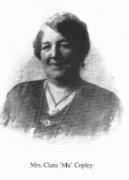|
|
||||||||||||||||||||||||
 |
Featured person
Recently added |
Alice Hart (c.1850 - 1931): |
||||||||||||||||||||||
Alice Hart and her husband Ernest, who was a surgeon and editor of the British Medical Journal, visited Donegal in 1883. The county had suffered severely from bad harvests, and a Donegal Famine Fund was set up by the Harts. Alice Hart felt that a possible short-term solution to the economic distress was the revival of cottage industries and in 1883, the Donegal Industrial Fund was started. After a successful showing of woven tweeds from Donegal at the Health Exhibition in London, Alice Hart opened a small shop in London to sell Donegal products. She personally experimented with the dying properties of the wild plants of Donegal: the heathers, mosses, roots and leaves, as well as soot and bog-ore. The hosiery made in Donegal and dyed with these dyes won the medal of the Sanitary Institute of Great Britain for 'inocuous vegetable dying'. She instigated a scheme whereby Irish women were encouraged to teach embroidery, later known as "Kells Embroidery". The designs were taken from early Irish manuscripts, and worked on linen with dyed and polished threads of flax. In 1885 "Kells Embroidery" won the gold medal at the Inventions Exhibition in London. In 1886 the Donegal Industrial Fund moved to a larger shop which became known as Donegal House. In addition, Alice Hart brought specialist teachers specifically to Donegal and wood-carving and carpentry were revived. The work was exhibited at Edinburgh, Liverpool, Paris, Dublin, Chicago and Olympia, where a model Donegal Industrial Village was built. The venture, though a resounding success, lacked the motivation to survive after the Harts retired in 1896.
| Born: | c.1850 |
| Died: | 1931 |
| Kate Newmann |
| Acknowledgements: Maud Hamill |


Home | Our Policies | Plaques | Browse | Search | Sponsors | Links | Help | Contact
Privacy & Disclaimer | Cookie Policy | Site Map | Website Design By K-Point
© 2024 Ulster History Circle









